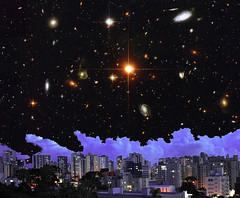 Image by Mathieu Struck via Flickr
Image by Mathieu Struck via Flickr
U.F.O.’S
It is generally thought, by the learned people on earth, that light from distant stars reach us here and of course we take their word for it without giving it much thought. Let us take a different angle on this theory. O.K. so light does travel and there is such a thing as the speed of light, but light does not travel from distant stars to earth reaching us at full strength. Light is instant at the core and only travels so far, and, the further it goes the wider the beam becomes, weakening its strength, restricting its travels, lighting up the sky within its range. If you have been lucky enough to witness an eclipse of the sun, you will have observed during a total eclipse, the light goes immediately the sun is switched off, even though it is so far away. When a distant star in our vision dies the light at the core extinguishes immediately so what the Hubble telescope; clear of earth’s clutter sees in the sky now! IS happening NOW! When you look at a lighthouse face on, as the beam approaches its light is instant, and as it goes round you see the beam side on then, note the distance the beam actually reaches. That’s right, it does not go on for ever, it only goes so far and weakens the wider it gets. Sailors only see the light when they come a certain distance from it, even when they are above the horizon to it. Different lighthouses have different flashes and different distances or strength of beam. Lamp-posts in a dark street together, light up the whole place, the beam or strength of one lamp is not sufficient enough to illuminate all of the street, even if the beam was pointing along the road instead of downwards, it would simply not he strong enough to reach the end of a lengthy street. The stars in our vision light up the night sky (along with our moon) and although the beam, from the stars do not reach us full strength the sheer volume together creates a glow bright enough to illuminate our sky. It’s not the reflection of OUR sun that lights up the distant stars in the night sky they are lit by their own source of power and as their rays do not reach earth in strength it’s our vision that penetrates space, first with our eyes, then with telescopes which are becoming more powerful and more efficient out in space. It is us, that is seeing further, not the light source of planets reaching here, or we would be able to see them more clearly without telescopes, as the light or the beam would have increased in size like a film projecting on a screen making them easier to see. There are plenty of stars out with our vision, yet, with and without telescopes and the delay between us registering, lies with our methods of sighting them not, their light taking so long to reach us.
When Hubble the space telescope was trained on what was thought to be an empty patch of sky, lights from other planets eventually came into view not, them just, reaching us but our vision or in this case Hubble’s vision reaching to the source or core of them. If the strength of light from all the stars did reach here it would be daylight all the time. That explains why from earth, we will never spot the Heavens that this book is about and, by now, you will have realised how far the planets (the largest pieces of debris from the Big Bang) really are and, why their lights will never be seen from earth unless, we produce a powerful enough telescope which is very unlikely.
![Reblog this post [with Zemanta]](http://img.zemanta.com/reblog_e.png?x-id=d04ceba3-6012-4f6b-80e2-3b31e07bea0c)

No comments:
Post a Comment